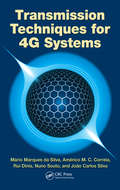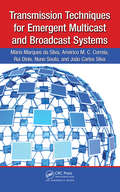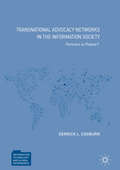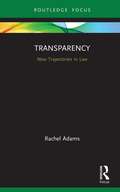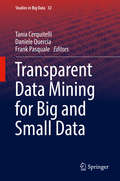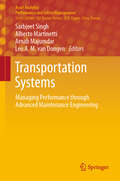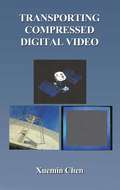- Table View
- List View
Transmission Medium (tactile)
by RnibThis diagram shows a high speed medium. 4 routers are linked in an elipse. The line connecting them is labelled as a high-speed backbone. A hub is joined onto the bottom router and has 3 pcs coming from it. The links from pc to hub are labelled ethernet.
Transmission Techniques for 4G Systems
by Mario Marques da Silva Americo Correia Rui Dinis Nuno Souto Joao Carlos SilvaFourth Generation (4G) wireless communication systems support current and emergent multimedia services such as mobile TV, social networks and gaming, high-definition TV, video teleconferencing, and messaging services. These systems feature the All-over-IP concept and boast improved quality of service. Several important R&D activities are curren
Transmission Techniques for 4G Systems
by Mario Marques da Silva Americo Correia Rui Dinis Nuno Souto Joao Carlos SilvaFourth Generation (4G) wireless communication systems support current and emergent multimedia services such as mobile TV, social networks and gaming, high-definition TV, video teleconferencing, and messaging services. These systems feature the All-over-IP concept and boast improved quality of service. Several important R&D activities are curren
Transmission Techniques for Emergent Multicast and Broadcast Systems
by Mario Marques da Silva Americo Correia Rui Dinis Nuno Souto Joao Carlos SilvaDescribing efficient transmission schemes for broadband wireless systems, Transmission Techniques for Emergent Multicast and Broadcast Systems examines advances in transmission techniques and receiver designs capable of supporting the emergent wireless needs for multimedia broadcast and multicast service (MBMS) requirements. It summarizes the resea
Transnational Advocacy Networks in the Information Society: Partners or Pawns? (Information Technology and Global Governance)
by Derrick L. CogburnThis book examines the role of transnational advocacy networks in enabling effective participation for individual citizens in the deliberative processes of global governance. Contextualized around the international conference setting of the United Nations-sponsored World Summit on the Information Society (WSIS) in 2003 and 2005, the book sees epistemic communities and information and communication technologies (ICTs) as critical to the effectiveness of this important organizational form. Historically, governments have dominated the official “conference diplomacy” surrounding these World Summits. However, reflecting the UN General Assembly resolution authorizing WSIS, transnational civil society and private sector organizations were invited to participate as official partners in a multistakeholder dialogue at the summit alongside the more traditional governments and international organizations. This book asks: are transnational advocacy networks active in the global information society influential partners in these global governance processes, or merely symbolic tokens—or pawns? Cogburn explores the factors that enabled some networks—such as the Internet Governance Caucus—to persist and thrive, while others failed, and sees linkages with epistemic communities—such as the Global Internet Governance Academic Network—and ICTs as critical to network effectiveness.
Transnational Higher Education in Computing Courses: Experiences and Reflections
by Jenny Carter Clive RosenThere has been exponential growth in transnational education (TNE) in the last few years as UK universities have looked to expand their markets. Recipient countries have sought short cuts to developing their higher education provision which has proved a lucrative income stream for some universities. But overseas collaborations are not without risk. Recipient countries can be concerned with external influence over curricula, quality being diluted and higher education being infected by neo-imperialism. These concerns are not without foundation. There are risks for providers too. Reputations can be damaged if academic standards are compromised. Conflicts of interest can occur between quality of provision and the pot of gold on offer. Staff can view overseas collaborations as distracting from their research and commitment to home students. Computing is a particularly popular subject for TNE, but critical thinking, analysis, independent learning, and creativity can be compromised. Preventing plagiarism is difficult. Constant changes in technology result in constant curricula revision which causes severe problems for overseas collaborations. This book focuses on TNE in the computing domain. However cross-cultural issues challenge TNE management and administration whatever the subject area. If the ever present tensions are not continuously monitored they can quickly threaten the sustainability of the collaboration. This book identifies many of the threats and some of the solutions. The readership for this book is truly global. Any international development officer in higher education considering an overseas collaboration will benefit from this book. Any academic becoming engaged in, or already involved with a TNE partnership, either as provider or recipient, will gain information and insight into the practice and issues. Researchers in TNE will discover more lines of enquiry. Students considering a course with an overseas provider or in coming to the UK to study will be better prepared thereby enabling a more fulfilling and rewarding experience. Anyone who has an interest in TNE, whether at the senior executive level, operational level, delivering programmes or as a recipient of TNE should read this book. The wealth of experience gathered here will provoke questions, prompt debate and offer solutions. It has been written by people who know the issues, bear the scars and are happy to share their knowledge. It will greatly benefit future transnational collaborations.
Transnational Security
by Marie-Helen MarasGlobalization and the easy movement of people, weapons, and toxins across borders has transformed security into a transnational phenomenon. Preventing transnational security threats has proven to be a very difficult challenge for governments and institutions around the world. Transnational Security addresses these issues, which are at the forefront
Transparency: New Trajectories in Law (New Trajectories in Law)
by Rachel AdamsThis book critiques the contemporary recourse to transparency in law and policy. This is, ostensibly, the information age. At the heart of the societal shift toward digitalisation is the call for transparency and the liberalisation of information and data. Yet, with the recent rise of concerns such as 'fake news', post-truth and misinformation, where the policy responses to all these phenomena has been a petition for even greater transparency, it becomes imperative to critically reflect on what this dominant idea means, whom it serves, and what the effects are of its power. In response, this book provides the first sustained critique of the concept of transparency in law and policy. It offers a concise overview of transparency in law and policy around the world, and critiques how this concept works discursively to delimit other forms of governance, other ways of knowing and other realities. It draws on the work of Michel Foucault on discourse, archaeology and genealogy, together with later Foucaultian scholars, including Gayatri Chakravorty Spivak and Judith Butler, as a theoretical framework for challenging and thinking anew the history and understanding of what has become one of the most popular buzzwords of 21st century law and governance. At the intersection of law and governance, this book will be of considerable interest to those working in these fields; but also to those engaged in other interdisciplinary areas, including society and technology, the digital humanities, technology laws and policy, global law and policy, as well as the surveillance society.
Transparency: New Trajectories in Law (New Trajectories in Law)
by Rachel AdamsThis book critiques the contemporary recourse to transparency in law and policy. This is, ostensibly, the information age. At the heart of the societal shift toward digitalisation is the call for transparency and the liberalisation of information and data. Yet, with the recent rise of concerns such as 'fake news', post-truth and misinformation, where the policy responses to all these phenomena has been a petition for even greater transparency, it becomes imperative to critically reflect on what this dominant idea means, whom it serves, and what the effects are of its power. In response, this book provides the first sustained critique of the concept of transparency in law and policy. It offers a concise overview of transparency in law and policy around the world, and critiques how this concept works discursively to delimit other forms of governance, other ways of knowing and other realities. It draws on the work of Michel Foucault on discourse, archaeology and genealogy, together with later Foucaultian scholars, including Gayatri Chakravorty Spivak and Judith Butler, as a theoretical framework for challenging and thinking anew the history and understanding of what has become one of the most popular buzzwords of 21st century law and governance. At the intersection of law and governance, this book will be of considerable interest to those working in these fields; but also to those engaged in other interdisciplinary areas, including society and technology, the digital humanities, technology laws and policy, global law and policy, as well as the surveillance society.
Transparency and Interpretability for Learned Representations of Artificial Neural Networks
by Richard MeyesArtificial intelligence (AI) is a concept, whose meaning and perception has changed considerably over the last decades. Starting off with individual and purely theoretical research efforts in the 1950s, AI has grown into a fully developed research field of modern times and may arguably emerge as one of the most important technological advancements of mankind. Despite these rapid technological advancements, some key questions revolving around the matter of transparency, interpretability and explainability of an AI’s decision-making remain unanswered. Thus, a young research field coined with the general term Explainable AI (XAI) has emerged from increasingly strict requirements for AI to be used in safety critical or ethically sensitive domains. An important research branch of XAI is to develop methods that help to facilitate a deeper understanding for the learned knowledge of artificial neural systems. In this book, a series of scientific studies are presented that shed light on how to adopt an empirical neuroscience inspired approach to investigate a neural network’s learned representation in the same spirit as neuroscientific studies of the brain.
Transparency in Politics and the Media: Accountability and Open Government
by Nigel Bowles James T. Hamilton David A. LevyIncreasingly governments around the world are experimenting with initiatives in transparency or 'open government'. These involve a variety of measures including the announcement of more user-friendly government websites, greater access to government data, the extension of freedom of information legislation and broader attempts to involve the public in government decision making. However, the role of the media in these initiatives has not hitherto been examined. This volume analyses the challenges and opportunities presented to journalists as they attempt to hold governments accountable in an era of professed transparency. In examining how transparency and open government initiatives have affected the accountability role of the press in the US and the UK, it also explores how policies in these two countries could change in the future to help journalists hold governments more accountable. This volume will be essential reading for all practising journalists, for students of journalism or politics, and for policymakers.
Transparency in Social Media: Tools, Methods and Algorithms for Mediating Online Interactions (Computational Social Sciences)
by Sorin Adam Matei Martha G. Russell Elisa BertinoThe volume presents, in a synergistic manner, significant theoretical and practical contributions in the area of social media reputation and authorship measurement, visualization, and modeling. The book justifies and proposes contributions to a future agenda for understanding the requirements for making social media authorship more transparent. Building on work presented in a previous volume of this series, Roles, Trust, and Reputation in Social Media Knowledge Markets, this book discusses new tools, applications, services, and algorithms that are needed for authoring content in a real-time publishing world. These insights may help people who interact and create content through social media better assess their potential for knowledge creation. They may also assist in analyzing audience attitudes, perceptions, and behavior in informal social media or in formal organizational structures. In addition, the volume includes several chapters that analyze the higher order ethical, critical thinking, and philosophical principles that may be used to ground social media authorship. Together, the perspectives presented in this volume help us understand how social media content is created and how its impact can be evaluated.The chapters demonstrate thought leadership through new ways of constructing social media experiences and making traces of social interaction visible. Transparency in Social Media aims to help researchers and practitioners design services, tools, or methods of analysis that encourage a more transparent process of interaction and communication on social media. Knowing who has added what content and with what authority to a specific online social media project can help the user community better understand, evaluate and make decisions and, ultimately, act on the basis of such information.
Transparent Data Mining for Big and Small Data (Studies in Big Data #32)
by Tania Cerquitelli Daniele Quercia Frank PasqualeThis book focuses on new and emerging data mining solutions that offer a greater level of transparency than existing solutions. Transparent data mining solutions with desirable properties (e.g. effective, fully automatic, scalable) are covered in the book. Experimental findings of transparent solutions are tailored to different domain experts, and experimental metrics for evaluating algorithmic transparency are presented. The book also discusses societal effects of black box vs. transparent approaches to data mining, as well as real-world use cases for these approaches.As algorithms increasingly support different aspects of modern life, a greater level of transparency is sorely needed, not least because discrimination and biases have to be avoided. With contributions from domain experts, this book provides an overview of an emerging area of data mining that has profound societal consequences, and provides the technical background to for readers to contribute to the field or to put existing approaches to practical use.
Transparent User Authentication: Biometrics, RFID and Behavioural Profiling
by Nathan ClarkeThis groundbreaking text examines the problem of user authentication from a completely new viewpoint. Rather than describing the requirements, technologies and implementation issues of designing point-of-entry authentication, the book introduces and investigates the technological requirements of implementing transparent user authentication – where authentication credentials are captured during a user’s normal interaction with a system. This approach would transform user authentication from a binary point-of-entry decision to a continuous identity confidence measure. Topics and features: discusses the need for user authentication; reviews existing authentication approaches; introduces novel behavioural biometrics techniques; examines the wider system-specific issues with designing large-scale multimodal authentication systems; concludes with a look to the future of user authentication.
Transport Simulation in Microelectronics (Progress in Numerical Simulation for Microelectronics #3)
by Alfred Kersch William J. MorokoffComputer simulation of semiconductor processing equipment and devices requires the use of a wide variety of numerical methods. Of these methods, the Monte Carlo approach is perhaps most fundamentally suited to mod eling physical events occurring on microscopic scales which are intricately connected to the particle structure of nature. Here physical phenomena can be simulated by following simulation particles (such as electrons, molecules, photons, etc. ) through a statistical sampling of scattering events. Monte Carlo is, however, generally looked on as a last resort due to the extremely slow convergence of these methods. It is of interest, then, to examine when in microelectronics it is necessary to use Monte Carlo methods, how such methods may be improved, and what are the alternatives. This book ad dresses three general areas of simulation which frequently arise in semicon ductor modeling where Monte Carlo methods playa significant role. In the first chapter the basic mathematical theory of the Boltzmann equation for particle transport is presented. The following chapters are devoted to the modeling of the transport processes and the associated Monte Carlo meth ods. Specific examples of industrial applications illustrate the effectiveness and importance of these methods. Two of these areas concern simulation of physical particles which may be assigned a time dependent position and velocity. This includes the molecules of a dilute gas used in such processing equipment as chemi cal vapor decomposition reactors and sputtering reactors. We also consider charged particles moving within a semiconductor lattice.
Transport Systems and Delivery of Cargo on East–West Routes (Studies in Systems, Decision and Control #155)
by Aleksander SładkowskiThis book discusses the problems of delivering goods from East and South-East Asia to Europe, presenting the regional transport problems experienced in Italy, Slovakia, Russia, Georgia, Kazakhstan, Uzbekistan and Poland. The book is divided into two parts. The first part is devoted to the analysis of various issues in global logistics and regional transport, which operate in transport corridors. The second part of the book focuses on solutions to some of the technical and informatics problems related to the organization of transportation along the East–West routes. Intended primarily for professionals involved in various aspects of cargo delivery along the East–West routes, the book is also useful for manufacturers, technical staff at logistics companies, managers, students of transport-related subjects, as well as for a wide range of readers interested in the current state of transport in different countries.
Transport Systems Telematics: 10th Conference, TST 2010, Katowice - Ustron, Poland, October 20-23, 2010. Selected Papers (Communications in Computer and Information Science #104)
by Jerzy MikulskiThe idea of telematics appeared more than a decade ago and it is possible to define it, in a general and simple way, as a communication system for collecting, processing and distributing information. The transport services market is definitely the most important area for telematic applications. Transport-telematics issues constitute a field of knowledge of transport that integrates information technology and telecommunications in applications for managing and controlling traffic in transport systems, stimulating technical and organizational activities that ensure improved effectiveness and safe operation of such systems. Integrated and cooperating telematic applications constitute intelligent transport systems. The basis of such systems is to efficiently collect and process information and to manage its flow within the system. This enables supplying information from almost all areas of transport activities in real time. Intelligent transport––supported by a number of integrated telecommunications, IT measurement and control engineering solutions, and by appropriate tools and software––comprises telematic applications. They have an extensive range of use in many areas of transport, allowing the integration of the means and types of transport, including its infrastructure, business organization and management processes. This monograph is a collection of selected papers presented at the jubilee transport telematics conference, TST 2010, and is the result of the work of many scientists associated with this area of knowledge and who had spent years with the conference.
Transportation and Information: Trends in Technology and Policy (SpringerBriefs in Computer Science)
by Piyushimita (Vonu) Thakuriah D. Glenn GeersTransformations in wireless connectivity and location-aware technologies hold the promise of bringing a sea-change in the way transportation information is generated and used in the future. Sensors in the transportation system, when integrated with those in other sectors (for example, energy, utility and health) have the potential to foster novel new ways of improving livability and sustainability.The end-result of these developments has been somewhat contradictory. Although automation in the transportation environment has become increasingly widespread, the level of involvement and active participation by people, in terms of co-creation and contribution of information, has also increased. As a result, the following two major trends have been observed: (1) increases in Machine-to- Machine (M2M) communications; and (2) increases in the variety and volume of User-Generated Content.In this transportation paradigm, the pervasive use of Information and Communication Technologies will serve as the foundation for mobility intelligence towards an “ubiquitous information-centered mobility environment”. However, many technical and operational questions, as well as social, management and legal challenges present themselves in the transformation to this vision. The book presents a non-technical review of research and initiatives and a discussion of such opportunities and challenges.
Transportation Infrastructure Engineering, Materials, Behavior and Performance: Proceedings of the 6th GeoChina International Conference on Civil & Transportation Infrastructures: From Engineering to Smart & Green Life Cycle Solutions -- Nanchang, China, 2021 (Sustainable Civil Infrastructures)
by Wynand JvdM Steyn Zhixin Wang Glynn HolleranSociety needs to travel to engage in productive and effective commerce, social, educational and related activities. Efficient travel is founded on an operational transport infrastructure system that is well-designed, engineering, constructed and maintained. This volume shares some of the latest innovations and thoughts in the areas of pavement infrastructure materials, behavior and performance. Access to this volume should enable the reader to gain an understanding of such novel information that should support improvements in the provision of an effective road transportation system for the benefit of the greater society served by the road network. The content is based on the contributions to the 6th GeoChina International Conference on Civil & Transportation Infrastructures: From Engineering to Smart & Green Life Cycle Solutions -- Nanchang, China, 2021.
Transportation Management with SAP TM 9: A Hands-on Guide to Configuring, Implementing, and Optimizing SAP TM
by Jayant Daithankar Tejkumar PanditThe implementation of a TMS solution is a highly complex and mission critical project. If executed correctly a good TMS can deliver a number of benefits to the organization in terms of optimization, greater efficiency, reduced errors and improved revenue through accurate invoicing. However a number of projects fail to realize these benefits for a host of reasons such as an incorrect product selection, over customization of the system and lack of detailed processes. The evaluation and selection of the right transportation management system is a very critical step in the successful implementation of a TMS product as well as ensuring that the organization is able to realize the benefits expected from the system.Transportation Management with SAP TM 9 is a guide for CIO/CXOs evaluating options for various transportation management solutions available in the market and helps inappropriate decision making before committing investment. A proven evaluation framework and guidance provided in the book can help decision makers with product selection and help to create a business case for management approval and design a future roadmap for the organization. The book provides a comprehensive understanding of what SAP transportation management is and is useful for teams involved in TM Implementation and roll outs to ensure preparedness. The book explains end-to-end freight life cycle processes, functional system landscape, implementation challenges and post go-live precautions required to optimize investments in SAP TM.Transportation Management with SAP TM 9 also acts as a step by step implementation guide with details of configuration required to set up a TM9 system. This book also covers the upgrade of SAP TM8 to SAP TM9 which will be useful for existing clients who are on TM 8. Nonavailability of SAP TM skilled resources is a major challenge faced by organizations and the book provides a detailed competency building plan along with skill set requirements to create a competent and trained workforce to manage-transformation.The current book available in the market on SAP TM is based on Version 6 release which does not cover air freight processes. Our book covers end-to-end air freight configuration scenarios for logistic companies.
Transportation Systems: Managing Performance through Advanced Maintenance Engineering (Asset Analytics)
by Sarbjeet Singh Alberto Martinetti Arnab Majumdar Leo A. M. van DongenThis book explores the application of breakthrough technologies to improve transportation performance. Transportation systems represent the “blood vessels” of a society, in which people and goods travel. They also influence people’s lives and affect the liveability and sustainability of our cities. The book shows how emergent technologies are able to monitor the condition of the structure in real time in order to schedule the right moment for maintenance activities an so reduce the disturbance to users.This book is a valuable resource for those involved in research and development in this field. Part I discusses the context of transportation systems, highlighting the major issues and challenges, the importance of understating human factors that could affect the maintenance operations and the main goals in terms of safety standards. Part II focuses on process-oriented innovations in transportation systems; this section stresses the importance of including design parameters in the planning, offering a comparison between risk-based and condition-based maintenance and, lastly, showing applications of emergent technologies. Part III goes on to reflect on the technical-oriented innovations, discussing the importance of studying the physical phenomena that are behind transportation system failures and problems. It then introduces the general trend of collecting and analyzing big data using real-world cases to evaluate the positive and negative aspects of adopting extensive smart sensors for gathering information on the health of the assets. The last part (IV) explores cultural and behavioural changes, and new knowledge management methods, proposing novel forms of maintenance and vocational training, and introduces the need for radical new visions in transportation for managing unexpected events.The continuous evolution of maintenance fields suggests that this compendium of “state-of-the-art” applications will not be the only one; the authors are planning a collection of cutting-edge examples of transportation systems that can assist researchers and practitioners as well as students in the process of understanding the complex and multidisciplinary environment of maintenance engineering applied to the transport sector.
Transportation Systems Security
by Allan McDougall Robert RadvanovskyHighlighting the importance of transportation to a country‘s infrastructure and survival, Transportation Systems Security presents the strategic and practical considerations involved in the implementation of physical, procedural, and managerial safeguards required to keep all modes of transportation up and running during an actual or potenti
Transporting Compressed Digital Video (The Springer International Series in Engineering and Computer Science #674)
by Xuemin ChenThe purpose of Transporting Compressed Digital Video is to introduce fundamental principles and important technologies used in design and analysis of video transport systems for many video applications in digital networks. In the past two decades, progress in digital video processing, transmission, and storage technologies, such as video compression, digital modulation, and digital storage disk, has proceeded at an astounding pace. Digital video compression is a field in which fundamental technologies were motivated and driven by practical applications so that they often lead to many useful advances. Especially, the digital video-compression standards, developed by the Moving Pictures Expert Group (MPEG) of the International Organization for Standardization (ISO) and the International Electrotechnical Commission (IEC), have enabled many successful digital-video applications. These applications range from digital-video disk (DVD) and multimedia CDs on a desktop computer, interactive digital cable television, to digital satellite networks. MPEG has become the most recognized standard for digital video compression. MPEG video is now an integral part of most digital video transmission and storage systems. Nowadays, video compression technologies are being used in almost all modern digital video systems and networks. Not only is video compression equipment being implemented to increase the bandwidth efficiency of communication systems, but video compression also provides innovative solutions to many related vid- networking problems. The subject of Transporting Compressed Digital Video includes several important topics, in particular video buffering, packet scheduling, multiplxing and synchronization.
The Transverse Information System: New Solutions for IS and Business Performance
by Francois Rivard Georges Abou Harb Philippe MeretInformation systems have an enormous potential for improving business performance. With this in mind, companies must set out to exploit and optimize this potential without delay in order to improve their efficiency and continue to set themselves apart from the competition. This comprehensive text provides the information needed to understand and implement these systems at a practical level.
The Transverse Information System: New Solutions for IS and Business Performance
by Francois Rivard Georges Abou Harb Philippe MeretInformation systems have an enormous potential for improving business performance. With this in mind, companies must set out to exploit and optimize this potential without delay in order to improve their efficiency and continue to set themselves apart from the competition. This comprehensive text provides the information needed to understand and implement these systems at a practical level.

